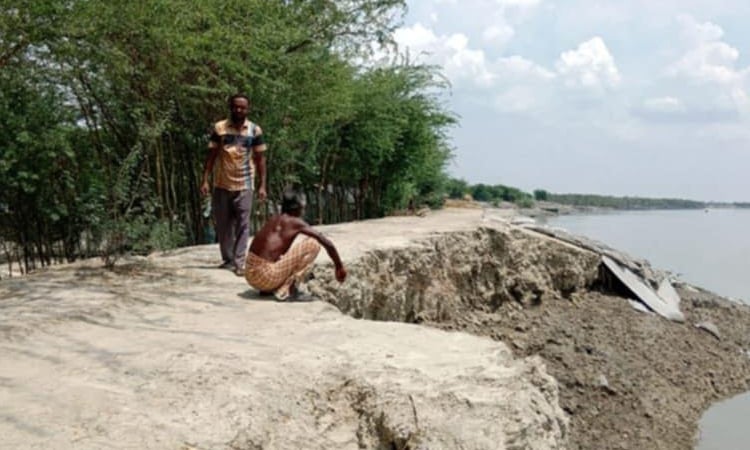News Flash
News Flash

By S M Zahid Hossain
KHULNA, May 24, 2025 (BSS) - Marking the 16 years since dreadful cyclone Aila struck on May 25, 2009, those who lost their loved ones are reminded of the faces they will never see again.
The devastating cyclone Aila accompanied by a tidal surge caused breaches in coastal embankments over 40 points including 27, submerging six unions of Koyra upazila in saline water.
The people of this region had to battle saline water intrusion for over three years.
A total of 41 people lost their lives during the super cyclone and tidal surge in the Khulna coastal belt.
Residents including thatched houses, schools, mosques, temples, roads, bridges, culverts, fish enclosures, crops, trees, and domestic animals were washed away.
People of the coastal region mostly Koyra upazila, have a cursed memory about 'Aila'.
Even today, remembering May 25, 2009, day sends shivers down the spines of the locals. Memories of their loved ones haunt those who lost family members. Due to a lack of burial space at the time, many were forced to shroud their dead and float them away in the river.
Sixteen years have passed, yet many affected families have not been able to fully recover. Braving immense hardship, the people of this region continue to survive against the odds.
A recent field visit at Koyra upazila revealed that many people are still living in makeshift huts on the embankments in South Bedkashi, North Bedkashi, Koyra Sadar, and Maharajpur unions.
Having lost their land and property, they have clung to the embankments, enduring tremendous hardship.
According to villagers, everything they owned was swept away by the tidal surge. Moreover, the aggressive erosion of the Shakbaria, Kapotakkho, and Koyra rivers has devoured homesteads and agricultural land. The environment of Koyra, now barren of trees, has not yet regained its former state. As a result, the area suffers from extreme heat during the dry season, making life unbearable.
Talking to BSS, Helal Uddin, an Aila victim of Ward no-4 in Koyra Sadar union mentioned that many public representatives visited after Aila and made numerous promises for rehabilitation, but all were in so-called political commitment.
However, some people refuse to leave the river islands because they still own land there. Even those who don't own land have grown emotionally attached to the place after living there for so long and are unwilling to move elsewhere, he added.
Arifur Rahman, a farmer from Sheikh Sardar Para in North Bedkashi union, said that farmers have managed to cultivate some crops in recent years, but the area is still not completely free from salinity.
Although the embankments have been repaired, they remain vulnerable. If not fully reinforced, these embankments may collapse again, submerging the region in saline water.
Acting chairman of Koyra Sadar Union, S M Lutfor Rahman, said that due to the devastation caused by Cyclone Aila, many people migrated to different parts of the country in search of livelihood. Sixteen years later, many still haven't been able to return to their ancestral homes.
According to the victims of Aila, a sustainable embankment is essential for their survival, without it, living in this region would be impossible.
After Aila, the area lost its sources of drinking water, and people are still crying out for access to clean water. In many places, people walk miles to fetch water from tube wells, they said.
They suggested that proper installation of deep tube wells and renovation of ponds with pond sand filters (PSFs) could alleviate the water crisis.
Imtiaz Uddin, General Secretary of the Koyra Development Coordination Committee, pointed out that the main problem in Koyra is river erosion.
"If this can be controlled, people can live in peace. Many embankments remain at risk and require urgent attention from the Water Development Board (WDB)," he said.
Talking to BSS, Upazila Education Officer Tapan Kumar Karmakar said that while many educational institutions have been renovated after Aila, several still remain in a dilapidated condition due to lack of funding. The roads to schools also remain in poor condition, causing significant difficulties for students.
Mashiul Abedin, Sub-Assistant Engineer of Khulna WDB, mentioned that repair work is ongoing in several vulnerable spots in Koyra's embankments under different project packages. Other risky areas have been identified and reported to higher authorities, and work will proceed in phases.
Mamunur Rashid, Project Implementation Officer and Member Secretary of the Upazila Disaster Management Committee remarked that among all the cyclones that have hit the coastal region in the last decade, Aila's impact on Koyra, adjacent to the Sundarbans, was the most devastating-damage that people are still struggling to recoup from damages.
Koyra UNO Ruli Biswas told BSS that for the safety of life and property in Koyra, sustainable embankments are essential.
Surrounded by rivers, the embankments in Koyra are its lifeline. Every year, somewhere in the upazila, an embankment breaks and causes flooding.
A sustainable embankment system is the only solution to protect this coastal region from future natural disasters, especially from cyclones, she added.